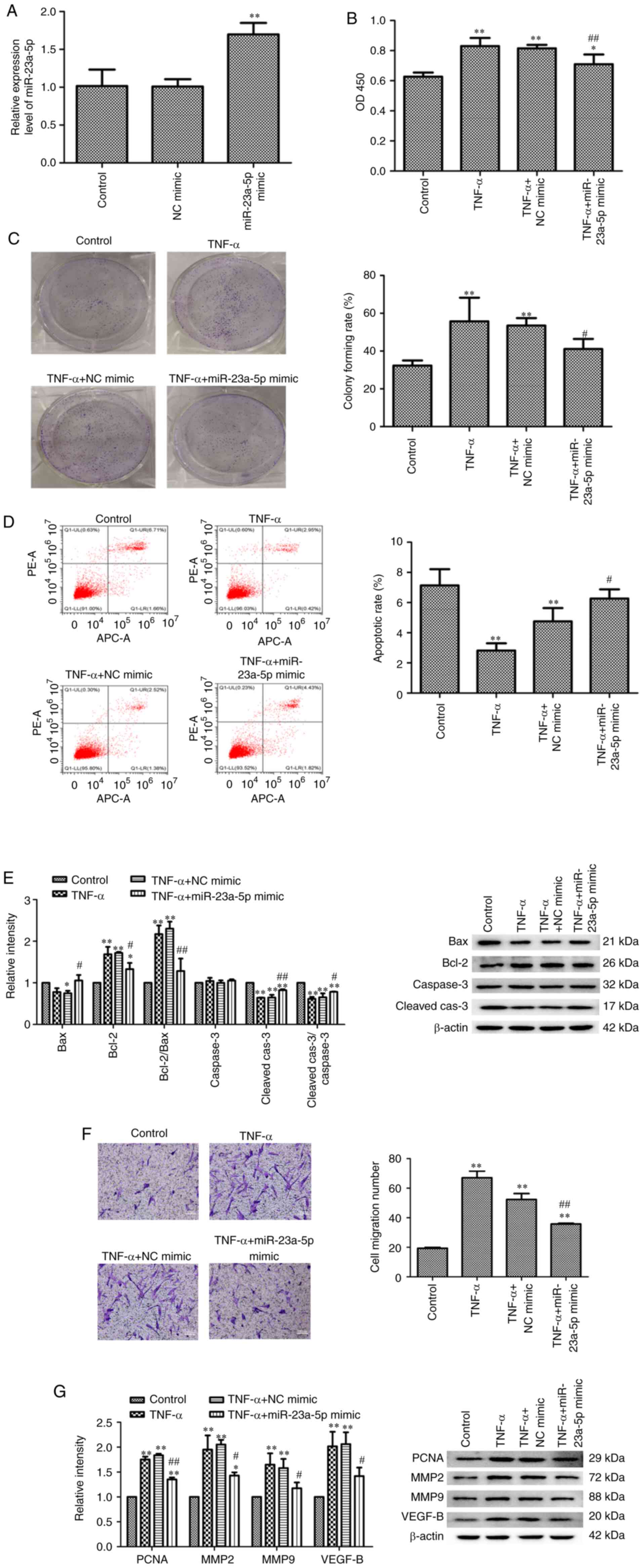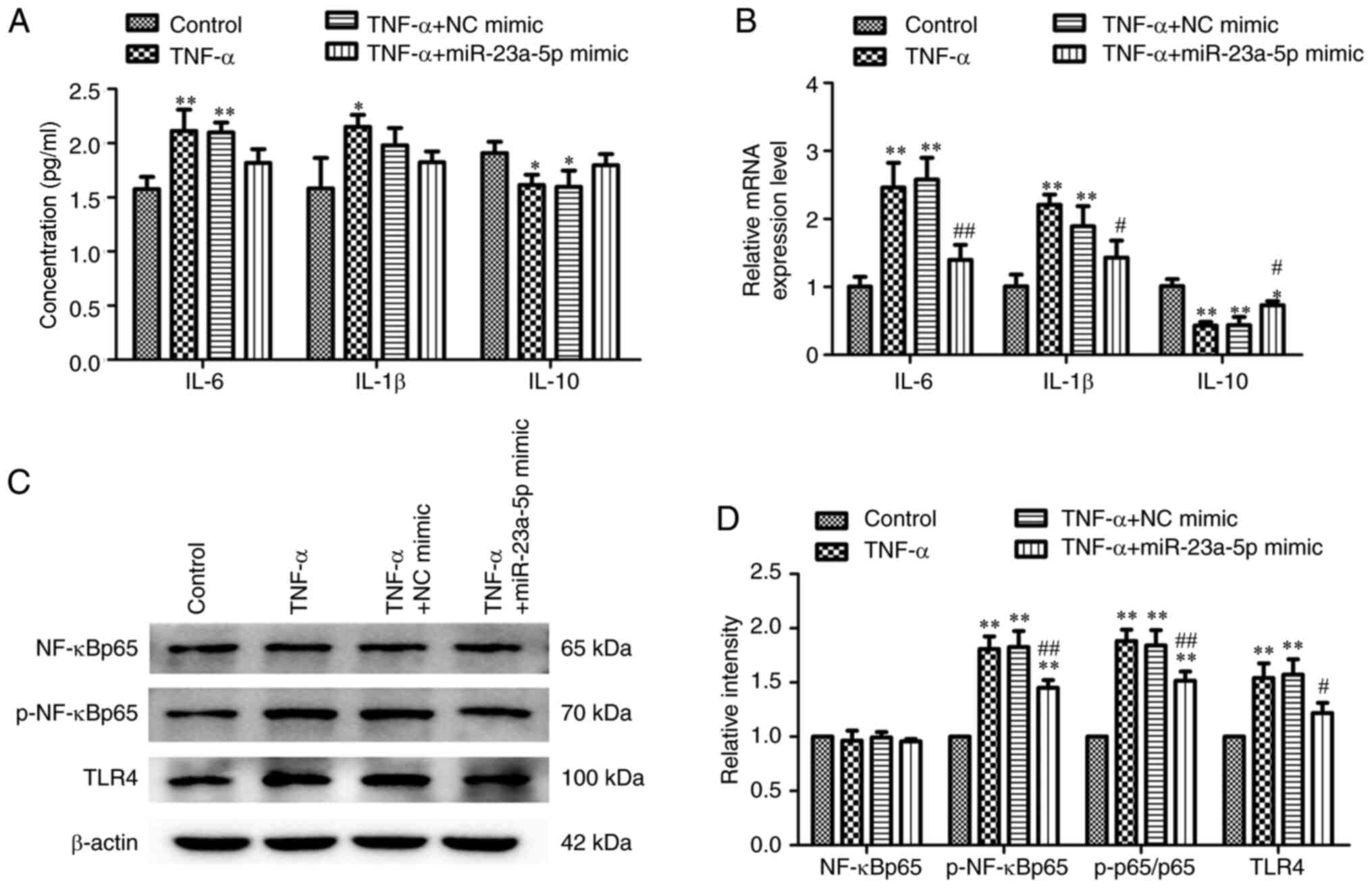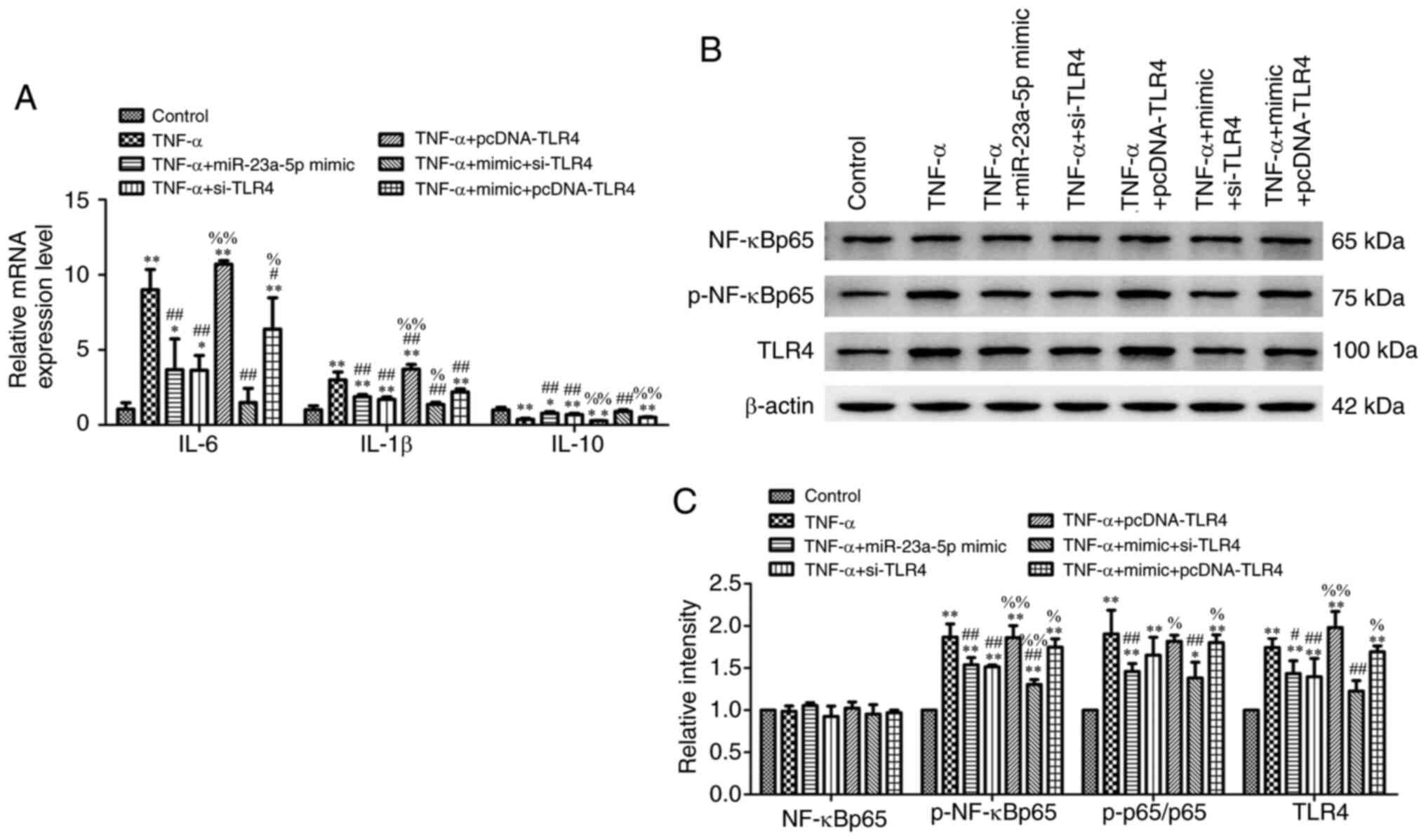|
1
|
Picerno V, Ferro F, Adinolfi A, Valentini
E, Tani C and Alunno A: One year in review: The pathogenesis of
rheumatoid arthritis. Clin Exp Rheumatol. 33:551–558.
2015.PubMed/NCBI
|
|
2
|
Smolen JS, Aletaha D and McInnes IB:
Rheumatoid arthritis. Lancet. 388:2023–2038. 2016.PubMed/NCBI View Article : Google Scholar
|
|
3
|
Syed Mohamed Suhail SM, Nur Atiqah I, Nur
Salimi Zakirah ZA, Lailatul Syazwani Z, Batis WW, Md Monoto EM,
Abdul Wahab A and Mohd Shahrir MS: Diagnostic performance of
anti-RA33 antibody as a serological marker for rheumatoid
arthritis. Malays J Pathol. 41:259–265. 2019.PubMed/NCBI
|
|
4
|
El-Maghraby HM, Rabie RA and Makram WK:
Correlation between relative expression of IL 17 and PERP in
rheumatoid arthritis patients and disease activity. Egypt J
Immunol. 26:19–29. 2019.PubMed/NCBI
|
|
5
|
Kim EK, Kwon JE, Lee SY, Lee EJ, Kim DS,
Moon SJ, Lee J, Kwok SK, Park SH and Cho ML: IL-17-mediated
mitochondrial dysfunction impairs apoptosis in rheumatoid arthritis
synovial fibroblasts through activation of autophagy. Cell Death
Dis. 8(e2565)2017.PubMed/NCBI View Article : Google Scholar
|
|
6
|
Wang S, Wang S, Li H, Zhu L and Wang Y:
Inhibition of the TGF-β/Smads signaling pathway attenuates
pulmonary fibrosis and induces anti-proliferative effect on
synovial fibroblasts in rheumatoid arthritis. Int J Clin Exp
Pathol. 12:1835–1845. 2019.PubMed/NCBI
|
|
7
|
Evangelatos G, Fragoulis GE, Koulouri V
and Lambrou GI: MicroRNAs in rheumatoid arthritis: From
pathogenesis to clinical impact. Autoimmun Rev.
18(102391)2019.PubMed/NCBI View Article : Google Scholar
|
|
8
|
Su Z, Yang Z, Xu Y, Chen Y and Yu Q:
MicroRNAs in apoptosis, autophagy and necroptosis. Oncotarget.
6:8474–8490. 2015.PubMed/NCBI View Article : Google Scholar
|
|
9
|
Rupaimoole R and Slack FJ: MicroRNA
therapeutics: Towards a new era for the management of cancer and
other diseases. Nat Rev Drug Discov. 16:203–222. 2017.PubMed/NCBI View Article : Google Scholar
|
|
10
|
McAlinden A and Im GI: MicroRNAs in
orthopaedic research: Disease associations, potential therapeutic
applications, and perspectives. J Orthop Res. 36:33–51.
2018.PubMed/NCBI View Article : Google Scholar
|
|
11
|
Chen YJ, Chang WA, Wu LY, Hsu YL, Chen CH
and Kuo PL: Systematic analysis of differential expression profile
in rheumatoid arthritis chondrocytes using next-generation
sequencing and bioinformatics approaches. Int J Med Sci.
15:1129–1142. 2018.PubMed/NCBI View Article : Google Scholar
|
|
12
|
Tseng CC, Wu LY, Tsai WC, Ou TT, Wu CC,
Sung WY, Kuo PL and Yen JH: Differential expression profiles of the
transcriptome and miRNA interactome in synovial fibroblasts of
rheumatoid arthritis revealed by next generation sequencing.
Diagnostics (Basel). 9(98)2019.PubMed/NCBI View Article : Google Scholar
|
|
13
|
Su LC, Huang AF, Jia H, Liu Y and Xu WD:
Role of microRNA-155 in rheumatoid arthritis. Int J Rheum Dis.
20:1631–1637. 2017.PubMed/NCBI View Article : Google Scholar
|
|
14
|
Jin S, Chen H, Li Y, Zhong H, Sun W, Wang
J, Zhang T, Ma J, Yan S, Zhang J, et al: Maresin 1 improves the
Treg/Th17 imbalance in rheumatoid arthritis through miR-21. Ann
Rheum Dis. 77:1644–1652. 2018.PubMed/NCBI View Article : Google Scholar
|
|
15
|
Chen Z, Wang H, Xia Y, Yan F and Lu Y:
Therapeutic potential of mesenchymal cell-derived
miRNA-150-5p-expressing exosomes in rheumatoid arthritis mediated
by the modulation of MMP14 and VEGF. J Immunol. 201:2472–2482.
2018.PubMed/NCBI View Article : Google Scholar
|
|
16
|
Liu X, Ni S, Li C, Xu N, Chen W, Wu M, van
Wijnen AJ and Wang Y: Circulating microRNA-23b as a new biomarker
for rheumatoid arthritis. Gene. 712(143911)2019.PubMed/NCBI View Article : Google Scholar
|
|
17
|
Huang W, Huang Y, Gu J, Zhang J, Yang J,
Liu S, Xie C, Fan Y and Wang H: miR-23a-5p inhibits cell
proliferation and invasion in pancreatic ductal adenocarcinoma by
suppressing ECM1 expression. Am J Transl Res. 11:2983–2994.
2019.PubMed/NCBI
|
|
18
|
Ganesan S, Palani HK, Lakshmanan V,
Balasundaram N, Alex AA, David S, Venkatraman A, Korula A, George
B, Balasubramanian P, et al: Stromal cells downregulate miR-23a-5p
to activate protective autophagy in acute myeloid leukemia. Cell
Death Dis. 10(736)2019.PubMed/NCBI View Article : Google Scholar
|
|
19
|
Quan J, Jin L, Pan X, He T and Lai Y, Chen
P, Lin C, Yang S, Zeng H and Lai Y: Oncogenic miR-23a-5p is
associated with cellular function in RCC. Mol Med Rep.
16:2309–2317. 2017.PubMed/NCBI View Article : Google Scholar
|
|
20
|
Yang S, Ye ZM, Chen S, Luo XY, Chen SL,
Mao L, Li Y, Jin H, Yu C, Xiang FX, et al: MicroRNA-23a-5p promotes
atherosclerotic plaque progression and vulnerability by repressing
ATP-binding cassette transporter A1/G1 in macrophages. J Mol Cell
Cardiol. 123:139–149. 2018.PubMed/NCBI View Article : Google Scholar
|
|
21
|
Yang JX, Xie P, Li YS, Wen T and Yang XC:
Osteoclast-derived miR-23a-5p-containing exosomes inhibit
osteogenic differentiation by regulating Runx2. Cell Signal.
70(109504)2020.PubMed/NCBI View Article : Google Scholar
|
|
22
|
Cao C, Chai Y, Shou S, Wang J, Huang Y and
Ma T: Toll-like receptor 4 deficiency increases resistance in
sepsis-induced immune dysfunction. Int Immunopharmacol. 54:169–176.
2018.PubMed/NCBI View Article : Google Scholar
|
|
23
|
Rocha DM, Caldas AP, Oliveira LL, Bressan
J and Hermsdorff HH: Saturated fatty acids trigger TLR4-mediated
inflammatory response. Atherosclerosis. 244:211–215.
2016.PubMed/NCBI View Article : Google Scholar
|
|
24
|
Aletaha D, Neogi T, Silman AJ, Funovits J,
Felson DT, Bingham CO III, Birnbaum NS, Burmester GR, Bykerk VP,
Cohen MD, et al: 2010 Rheumatoid arthritis classification criteria:
An American college of rheumatology/european league against
rheumatism collaborative initiative. Arthritis Rheum. 62:2569–2581.
2010.PubMed/NCBI View Article : Google Scholar
|
|
25
|
Livak KJ and Schmittgen TD: Analysis of
relative gene expression data using real-time quantitative PCR and
the 2(-Delta Delta C(T)) method. Methods. 25:402–408.
2001.PubMed/NCBI View Article : Google Scholar
|
|
26
|
Kong L, Wang L, Zhao Q, Di G and Wu H:
Rhodojaponin II inhibits TNF-α-induced inflammatory cytokine
secretion in MH7A human rheumatoid arthritis fibroblast-like
synoviocytes. J Biochem Mol Toxicol. 34(e22551)2020.PubMed/NCBI View Article : Google Scholar
|
|
27
|
Nakasa T, Miyaki S, Okubo A, Hashimoto M,
Nishida K, Ochi M and Asahara H: Expression of microRNA-146 in
rheumatoid arthritis synovial tissue. Arthritis Rheum.
58:1284–1292. 2008.PubMed/NCBI View Article : Google Scholar
|
|
28
|
Xia Z, Meng F, Liu Y, Fang Y, Wu X, Zhang
C, Liu D and Li G: Decreased MiR-128-3p alleviates the progression
of rheumatoid arthritis by up-regulating the expression of TNFAIP3.
Biosci Rep. 38(BSR20180540)2018.PubMed/NCBI View Article : Google Scholar
|
|
29
|
Fulci V, Scappucci G, Sebastiani GD,
Giannitti C, Franceschini D, Meloni F, Colombo T, Citarella F,
Barnaba V, Minisola G, et al: miR-223 is overexpressed in
T-lymphocytes of patients affected by rheumatoid arthritis. Hum
Immunol. 71:206–211. 2010.PubMed/NCBI View Article : Google Scholar
|
|
30
|
Gao J, Kong R, Zhou X, Ji L, Zhang J and
Zhao D: MiRNA-126 expression inhibits IL-23R mediated TNF-α or
IFN-γ production in fibroblast-like synoviocytes in a mice model of
collagen-induced rheumatoid arthritis. Apoptosis. 23:607–615.
2018.PubMed/NCBI View Article : Google Scholar
|
|
31
|
Wei XJ, Li XW, Lu JL, Long ZX, Liang JQ,
Wei SB, Lu CX and Lu WZ: MiR-20a regulates fibroblast-like
synoviocyte proliferation and apoptosis in rheumatoid arthritis.
Eur Rev Med Pharmacol Sci. 21:3886–3893. 2017.PubMed/NCBI
|
|
32
|
Liu L, Zuo Y, Xu Y, Zhang Z, Li Y and Pang
J: MiR-613 inhibits proliferation and invasion and induces
apoptosis of rheumatoid arthritis synovial fibroblasts by direct
down-regulation of DKK1. Cell Mol Biol Lett. 24(8)2019.PubMed/NCBI View Article : Google Scholar
|
|
33
|
Kurkewich JL, Hansen J, Klopfenstein N,
Zhang H, Wood C, Boucher A, Hickman J, Muench DE, Grimes HL and
Dahl R: The miR-23a~27a~24-2 microRNA cluster buffers transcription
and signaling pathways during hematopoiesis. PLoS Genet.
13(e1006887)2017.PubMed/NCBI View Article : Google Scholar
|
|
34
|
Wang N, Tan HY, Feng YG, Zhang C, Chen F
and Feng Y: microRNA-23a in human cancer: Its roles, mechanisms and
therapeutic relevance. Cancers (Basel). 11(7)2018.PubMed/NCBI View Article : Google Scholar
|
|
35
|
Huang J, Jiang R, Chu X, Wang F, Sun X,
Wang Y and Pang L: Overexpression of microRNA-23a-5p induces
myocardial infarction by promoting cardiomyocyte apoptosis through
inhibited of PI3K/AKT signalling pathway. Cell Biochem Funct.
38:1047–1055. 2020.PubMed/NCBI View Article : Google Scholar
|
|
36
|
Caserta S, Kern F, Cohen J, Drage S,
Newbury SF and Llewelyn MJ: Circulating plasma microRNAs can
differentiate human sepsis and systemic inflammatory response
syndrome (SIRS). Sci Rep. 6(28006)2016.PubMed/NCBI View Article : Google Scholar
|
|
37
|
Roncon P, Soukupovà M, Binaschi A,
Falcicchia C, Zucchini S, Ferracin M, Langley SR, Petretto E,
Johnson MR, Marucci G, et al: MicroRNA profiles in hippocampal
granule cells and plasma of rats with pilocarpine-induced
epilepsy-comparison with human epileptic samples. Sci Rep.
5(14143)2015.PubMed/NCBI View Article : Google Scholar
|
|
38
|
Li Y, Quan J, Pan X, Zhou J, He A, Lai Y
and Zhou G: Suppressing cell growth and inducing apoptosis by
inhibiting miR-23a-5p in human bladder cancer. Mol Med Rep.
18:5256–5260. 2018.PubMed/NCBI View Article : Google Scholar
|
|
39
|
Yamanaka H: TNF as a target of
inflammation in rheumatoid arthritis. Endocr Metab Immune Disord
Drug Targets. 15:129–134. 2015.PubMed/NCBI View Article : Google Scholar
|
|
40
|
Lee AS, Ellman MB, Yan D, Kroin JS, Cole
BJ, van Wijnen AJ and Im HJ: A current review of molecular
mechanisms regarding osteoarthritis and pain. Gene. 527:440–447.
2013.PubMed/NCBI View Article : Google Scholar
|
|
41
|
Guo X, Wang S, Godwood A, Close D, Ryan
PC, Roskos LK and White WI: Pharmacodynamic biomarkers and
differential effects of TNF- and GM-CSF-targeting biologics in
rheumatoid arthritis. Int J Rheum Dis. 22:646–653. 2019.PubMed/NCBI View Article : Google Scholar
|
|
42
|
Wei ST, Sun YH, Zong SH and Xiang YB:
Serum levels of IL-6 and TNF-α may correlate with activity and
severity of rheumatoid arthritis. Med Sci Monit. 21:4030–4038.
2015.PubMed/NCBI View Article : Google Scholar
|
|
43
|
Liu W, Zhang Y, Zhu W, Ma C, Ruan J, Long
H and Wang Y: Sinomenine inhibits the progression of rheumatoid
arthritis by regulating the secretion of inflammatory cytokines and
monocyte/macrophage subsets. Front Immunol. 9(2228)2018.PubMed/NCBI View Article : Google Scholar
|
|
44
|
ElAtta AA, Ali Y, Bassyouni I and Talaat
R: Correlation of myomir-206 and proinflammatory cytokines (IL-16
and IL-17) in patients with rheumatoid arthritis. Reumatologia.
57:72–77. 2019.PubMed/NCBI View Article : Google Scholar
|
|
45
|
Wang ZC, Lu H, Zhou Q, Yu SM, Mao YL,
Zhang HJ, Zhang PC and Yan WJ: MiR-451 inhibits synovial
fibroblasts proliferation and inflammatory cytokines secretion in
rheumatoid arthritis through mediating p38MAPK signaling pathway.
Int J Clin Exp Pathol. 8:14562–14567. 2015.PubMed/NCBI
|
|
46
|
Li J, Song Q, Shao L, Zhang LL, Guo XH and
Mao YJ: MiR-124a inhibits proliferation and invasion of rheumatoid
arthritis synovial fibroblasts. Eur Rev Med Pharmacol Sci.
22:4581–4588. 2018.PubMed/NCBI View Article : Google Scholar
|
|
47
|
Nagaoka A, Takizawa N, Takeuchi R, Inaba
Y, Saito I, Nagashima Y, Saito T and Aoki I: Possible involvement
of peptidylprolyl isomerase Pin1 in rheumatoid arthritis. Pathol
Int. 61:59–66. 2011.PubMed/NCBI View Article : Google Scholar
|
|
48
|
Yang S and Yang Y: Downregulation of
microRNA-221 decreases migration and invasion in fibroblast-like
synoviocytes in rheumatoid arthritis. Mol Med Rep. 12:2395–2401.
2015.PubMed/NCBI View Article : Google Scholar
|
|
49
|
Hong BK, You S, Yoo SA, Park D, Hwang D,
Cho CS and Kim WU: MicroRNA-143 and -145 modulate the phenotype of
synovial fibroblasts in rheumatoid arthritis. Exp Mol Med.
49(e363)2017.PubMed/NCBI View Article : Google Scholar
|
|
50
|
Gu X, Gao Y, Mu DG and Fu EQ: MiR-23a-5p
modulates mycobacterial survival and autophagy during mycobacterium
tuberculosis infection through TLR2/MyD88/NF-κB pathway by
targeting TLR2. Exp Cell Res. 354:71–77. 2017.PubMed/NCBI View Article : Google Scholar
|
|
51
|
Yang J, Li Y, Yu Z, Zhou Y, Tu J, Lou J
and Wang Y: Circular RNA Circ100084 functions as sponge of
miR-23a-5p to regulate IGF2 expression in hepatocellular carcinoma.
Mol Med Rep. 21:2395–2404. 2020.PubMed/NCBI View Article : Google Scholar
|
|
52
|
Dubois Cauwelaert N, Baldwin SL, Orr MT,
Desbien AL, Gage E, Hofmeyer KA and Coler RN: Antigen presentation
by B cells guides programing of memory CD4(+) T-cell responses to a
TLR4-agonist containing vaccine in mice. Eur J Immunol.
46:2719–2729. 2016.PubMed/NCBI View Article : Google Scholar
|
|
53
|
Kato K, Hanss AD, Zemskova MA, Morgan NE,
Kim M, Knox KS, Lin Y, Lillehoj EP and Kim KC: Pseudomonas
aeruginosa increases MUC1 expression in macrophages through the
TLR4-p38 pathway. Biochem Biophys Res Commun. 492:231–235.
2017.PubMed/NCBI View Article : Google Scholar
|
|
54
|
Zhang M, Wang C, Wu J, Ha X, Deng Y, Zhang
X, Wang J, Chen K, Feng J, Zhu J, et al: The effect and mechanism
of KLF7 in the TLR4/NF-κB/IL-6 inflammatory signal pathway of
adipocytes. Mediators Inflamm. 2018(1756494)2018.PubMed/NCBI View Article : Google Scholar
|
|
55
|
Layunta E, Latorre E, Forcén R, Grasa L,
Castro M, Arias MA, Alcalde AI and Mesonero JE: NOD2 modulates
serotonin transporter and interacts with TLR2 and TLR4 in
intestinal epithelial cells. Cell Physiol Biochem. 47:1217–1229.
2018.PubMed/NCBI View Article : Google Scholar
|
|
56
|
Rallabhandi P, Bell J, Boukhvalova MS,
Medvedev A, Lorenz E, Arditi M, Hemming VG, Blanco JCG, Segal DM
and Vogel SN: Analysis of TLR4 polymorphic variants: New insights
into TLR4/MD-2/CD14 stoichiometry, structure, and signaling. J
Immunol. 177:322–332. 2006.PubMed/NCBI View Article : Google Scholar
|
|
57
|
Liu W, Wu YH, Zhang L, Xue B, Wang Y, Liu
B, Liu XY, Zuo F, Yang XY, Chen FY, et al: MicroRNA-146a suppresses
rheumatoid arthritis fibroblast-like synoviocytes proliferation and
inflammatory responses by inhibiting the TLR4/NF-kB signaling.
Oncotarget. 9:23944–23959. 2018.PubMed/NCBI View Article : Google Scholar
|
|
58
|
Yan S, Wang P, Wang J, Yang J, Lu H, Jin
C, Cheng M and Xu D: Long non-coding RNA HIX003209 promotes
inflammation by sponging miR-6089 via TLR4/NF-κB signaling pathway
in rheumatoid arthritis. Front Immunol. 10(2218)2019.PubMed/NCBI View Article : Google Scholar
|
|
59
|
Wang Y, Zheng F, Gao G, Yan S, Zhang L,
Wang L, Cai X, Wang X, Xu D and Wang J: MiR-548a-3p regulates
inflammatory response via TLR4/NF-κB signaling pathway in
rheumatoid arthritis. J Cell Biochem. 2018.PubMed/NCBI View Article : Google Scholar : (Epub ahead of
print).
|




















